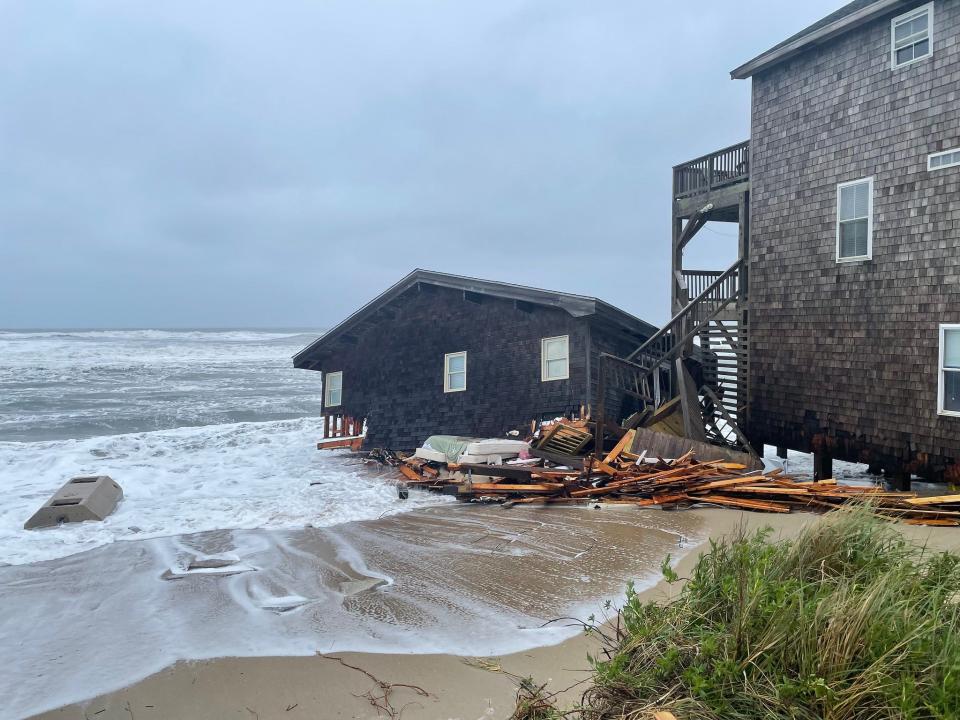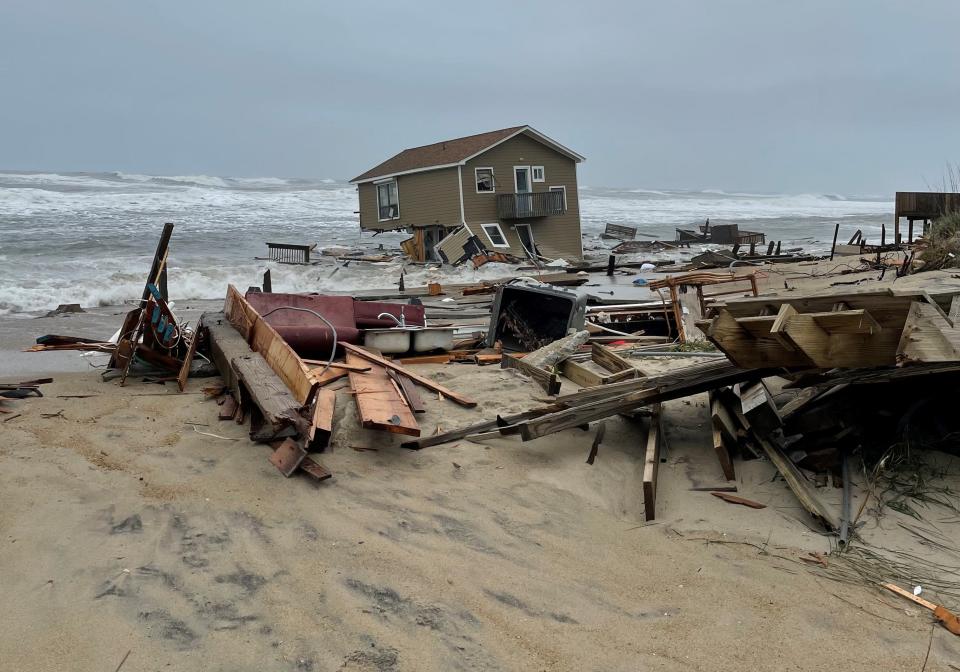A pair of North Carolina homes fell into the ocean this week. Why experts say it 'won't be the last time.'
Scattered debris and wooden planks poking up from soggy sand were all that remained of a coastal North Carolina house’s foundation earlier this week.
That day, a low pressure system sent powerful winds and water lashing up the Outer Banks’ eastern coastline. Mere feet away, strong waves splashed and battered the unoccupied home’s damaged structure from all sides as it rested at its new address – the ocean’s edge.
Just up the road on Ocean Drive in Rodanthe, a similar scenario played out. Another unoccupied home’s structure collapsed into the water amid severe weather conditions.
They were the second and third homes this year to collapse in Rodanthe, according to the National Park Service and officials in Dare County, North Carolina. In February, another uninhabited home collapsed, resulting in a 15-mile-long debris field that was cleaned up over Valentine's Day weekend.
CLIMATE CHANGE: There's a 50-50 chance Earth will reach critical mark within 5 years, report says
Experts told USA TODAY these occurrences won’t be the last, particularly as the Eastern Seaboard enters the 2022 hurricane season.
“The highest strike potential is actually right near Cape Hatteras, typically seeing a hurricane roughly once every two years to come through the area,” AccuWeather Senior Meteorologist Alan Reppert said.

Severe storms impacting coastlines or inland areas – like Hurricanes Michael, Dorian and Matthew – have become more common in the past decade, including along the Outer Banks, Reppert said.
In 2011, Hurricane Irene’s powerful winds and catastrophic storm surge – between 10 to 12 feet of water, according to the National Weather Service – left a landscape-altering scar on the area that is still visible more than 10 years later.
"There were some new inlets that formed due to Hurricane Irene, and that created several washouts and damaged roads going onto Hatteras Island,” Reppert said.
Beyond the Outer Banks
These coastal issues aren’t limited to the Outer Banks. The detrimental effects of severe storms and shoreline erosion can strike homes up and down the eastern, Gulf and western coasts of the United States, said Sheldon Yellen, CEO of BELFOR Property Restoration.
“Many cities along U.S. coastlines in states like California, Florida, South Carolina, New Jersey, Louisiana, Maryland and more are facing similar problems due to the ever-worsening coastal erosion and rising sea levels,” Yellen wrote in an email to USA TODAY.
Some communities across the nation try to mitigate the threat by building sea walls to protect homes and businesses, while others are combatting beach erosion the best way they know how: beach nourishment, thanks to help from the U.S. Army Corps of Engineers.
WHAT ABOUT VACATION RENTALS? Here’s what you should know
For example, Louisiana’s ongoing Terrebonne Basin Barrier Island and Beach Nourishment project involves restoring over seven miles of shoreline and about 1,257 acres of marshland, dunes and beaches with 9.2 million cubic yards of sediment, according to the Coastal Protection and Restoration authority.
In the case of vulnerable barrier islands like the Outer Banks, those decades-old shoreline homes didn’t start out sitting so close to the ocean. They were most likely protected by large dunes and wide swaths of beach in the past, and Reppert said homes in many cases were initially built hundreds of feet from the water.
“Now, as the dunes have pushed back, we've actually seen these homes get almost into the water permanently, and that's caused a lot of the issues that we're seeing with most of these homes that we're seeing collapse,” Reppert said.

Sea level rise speeds up the naturally occurring erosion and narrows the beaches – and the distance between the homes and water – in the process, according to Dr. Reide Corbett, executive director of the Coastal Studies Institute at East Carolina University.
These issues won't just wash away.
“It won’t be the last time we see significant shoreline erosion and waves underneath houses," Corbett said.
"Whether it's the Outer Banks, the Gulf Coast, or, you know, pick a coastal community around the world, these challenges are something that we are going to be dealing with moving forward, and we need to take a proactive approach to how we can make our coastal communities more resilient," he added.
How to 'shore up' a coastal home
The homes that fell recently into the Atlantic Ocean were examples of properties that were not properly protected by the homeowners, according to Dare County manager Bobby Outten.
“They didn’t repair the home, didn’t do anything to prevent it from falling in, and ultimately the ocean took it," Outten told 13 News Now.
“It’s a shame for those people who own those homes,” Outten said. “That area is an area of high erosion and it’s something that wasn’t unexpected.”
It’s possible to “shore up” a coastal home to boost its structural resiliency against the energy associated with strong storms, like resetting or adding additional pilings beneath a house, said Corbett, a North Carolina native.
Some homeowners with the resources to do so can relocate the property to a place farther inland to protect it.
TRYING TO TURN THE TIDE: Chicago's treasured shores are being swamped by rising waters
“We’ve seen several homes that have been moved into not the first row of homes, but maybe a second or third row of homes,” Corbett said.
In the Cape Hatteras area, Dare County home inspectors give residents a heads up on whether their seaside homes are still safe for occupancy, face a risk of collapse or if some repairs are needed to build the homes' resiliency before severe conditions threaten the coast.
Other steps for coastal homeowners in vulnerable, flood-prone spots include improving the home’s land grading or slope, changing the property’s landscaping and installing water barriers and new drainage systems, Yellen suggested.
Preparation is key, Yellen said.
"People who live in coastal towns across the country should understand how to prepare for hurricanes, coastal erosion, unpredictable sea levels and more to ensure their homes are adequately protected from potential disaster," he said.
Contributing: Gareth McGrath, USA TODAY NETWORK
This article originally appeared on USA TODAY: Outer Banks homes washed out to sea. Experts warn it'll happen again.

